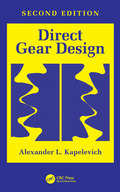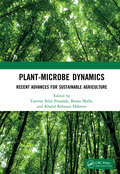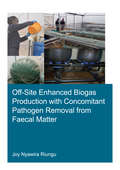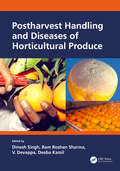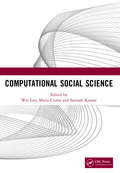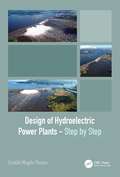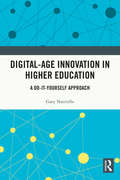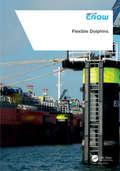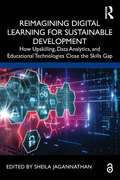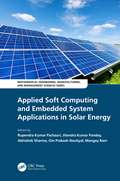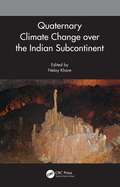- Table View
- List View
Direct Gear Design
by Alexander L. KapelevichThe updated and improved second edition of Direct Gear Design details a nonstandard gear design approach that makes it possible to significantly improve gear drive performance. Providing engineers with gear design solutions beyond standard limits, this book delivers engineers with practical and innovative solutions to optimize gearing technologies.The majority of modern gears are over-standardized, not allowing gear design engineers to see possible gear design solutions outside of standard limits. The book explores opportunities to improve and optimize gears beyond these limitations. The method of Direct Gear Design has been proven to maximise gear drive performance, increase transmission load capacity and efficiency, and reduce size and weight. Discussing the use of gears made from powder metal and plastic, the book surveys gear manufacture and makes use of extensive references to encourage further exploration of gear design innovation. Additionally, the book provides an overview of manufacturing technologies and traditional gear design, as well as covering topics such as asymmetric gears, tolerance selection and measurement methods of custom gears.Written accessibly, with a focus on practical examples, this fully updated edition will serve as a guidebook for all professionals exploring high-performance gearing system technologies.
Plant-Microbe Dynamics: Recent Advances for Sustainable Agriculture
by Tanveer Bilal PirzadahPlants and microbes have co-evolved and interacted with each other in nature. Understanding the complex nature of the plant-microbe interface can pave the way for novel strategies to improve plant productivity in an eco-friendly manner. The microbes associated with plants, often called plant microbiota, are an integral part of plant life. The significance of the plant microbiome is a reliable approach toward sustainability to meet future food crises and rejuvenate soil health. Profiling plant-associate microbiomes (genome assemblies of all microbes) is an emerging concept in understanding plant-microbe interactions. Microbiota extends the plant capacity to acclimatize fluctuating environmental conditions through several mechanisms. Thus, unraveling the mystery of plant-microbe dynamics through latest technologies to better understand the role of metabolites and signal pathway mechanisms is very important. This book shares the latest insight on omics technologies to unravel plant-microbe dynamic interactions and other novel phytotechnologies for cleaning contaminated soils. Besides, it also provides brief insight on the recently discovered clustered regularly interspaced short palindromic repeats CRISPR-Cas9, which is a genome editing tool to explore plant-microbe interactions and how this genome editing tool helps to improve the ability of microbes/plants to combat abiotic/biotic stresses.
Direct Gear Design
by Alexander L. KapelevichThe updated and improved second edition of Direct Gear Design details a nonstandard gear design approach that makes it possible to significantly improve gear drive performance. Providing engineers with gear design solutions beyond standard limits, this book delivers engineers with practical and innovative solutions to optimize gearing technologies.The majority of modern gears are over-standardized, not allowing gear design engineers to see possible gear design solutions outside of standard limits. The book explores opportunities to improve and optimize gears beyond these limitations. The method of Direct Gear Design has been proven to maximise gear drive performance, increase transmission load capacity and efficiency, and reduce size and weight. Discussing the use of gears made from powder metal and plastic, the book surveys gear manufacture and makes use of extensive references to encourage further exploration of gear design innovation. Additionally, the book provides an overview of manufacturing technologies and traditional gear design, as well as covering topics such as asymmetric gears, tolerance selection and measurement methods of custom gears.Written accessibly, with a focus on practical examples, this fully updated edition will serve as a guidebook for all professionals exploring high-performance gearing system technologies.
Off-Site Enhanced Biogas Production with Concomitant Pathogen Removal from Faecal Matter (IHE Delft PhD Thesis Series)
by Joy Nyawira RiunguGlobally, 2.7 billion people are using onsite sanitation systems, particularly in low income, high density settlements (LIHDS) in urban areas of developing countries. However, treatment technologies to manage the faecal sludge (FS) generated from these systems are often not in place, leading to high risks for environmental and public health. The development of replicable and effective technologies for FS treatment is key in addressing this challenge. This research focused on development of an innovative FS stabilisation technology and addressed key constraints in anaerobic FS treatment: inadequate pathogen inactivation and limitations in biochemical energy recovery. The developed two-stage reactor system consists of an acidogenic reactor fed with mixtures of FS and market waste to facilitate pathogen inactivation, and a subsequent methanogenic plug-flow reactor for enhanced methane production. Due to its potential for application as an off-site FS treatment technology at any scale, receiving any type of faecal matter, collected from different types of sanitary systems, the system provides an option for FS stabilisation for LIHDS. Additionally, the research evaluated the limitations of sanitation provision in LIHDS, and proposes methods for creating an enabling environment for full-scale implementation of onsite systems. The presented results contribute to designing appropriate sanitation interventions in LIHDS.
Off-Site Enhanced Biogas Production with Concomitant Pathogen Removal from Faecal Matter (IHE Delft PhD Thesis Series)
by Joy Nyawira RiunguGlobally, 2.7 billion people are using onsite sanitation systems, particularly in low income, high density settlements (LIHDS) in urban areas of developing countries. However, treatment technologies to manage the faecal sludge (FS) generated from these systems are often not in place, leading to high risks for environmental and public health. The development of replicable and effective technologies for FS treatment is key in addressing this challenge. This research focused on development of an innovative FS stabilisation technology and addressed key constraints in anaerobic FS treatment: inadequate pathogen inactivation and limitations in biochemical energy recovery. The developed two-stage reactor system consists of an acidogenic reactor fed with mixtures of FS and market waste to facilitate pathogen inactivation, and a subsequent methanogenic plug-flow reactor for enhanced methane production. Due to its potential for application as an off-site FS treatment technology at any scale, receiving any type of faecal matter, collected from different types of sanitary systems, the system provides an option for FS stabilisation for LIHDS. Additionally, the research evaluated the limitations of sanitation provision in LIHDS, and proposes methods for creating an enabling environment for full-scale implementation of onsite systems. The presented results contribute to designing appropriate sanitation interventions in LIHDS.
Postharvest Handling and Diseases of Horticultural Produce
by Dinesh Singh Ram Roshan Sharma V. Devappa Deeba KamilPostharvest Handling and Diseases of Horticultural Produce describes all the postharvest techniques, handling, pre-cooling, postharvest treatment, edible coating and storage of the horticultural produce available to handle perishable horticultural food commodities, covering the areas of horticulture, agricultural process engineering, postharvest technology, plant pathology and microbiology. Postharvest diseases of major fruits and vegetables, with their causal agents, are described. The integrative strategies for management of postharvest diseases include effectively inhibiting the growth of pathogens, enhancing the resistance of hosts and improving environmental conditions, with results that are favourable to the host and unfavourable to the pathogen growth including biotechnological approaches. Adopting a thematic style, chapters are organized by type of treatment, with sections devoted to postharvest risk factors and their amelioration. The chapters are written by experts in the fields of plant pathology, horticulture, food science etc., and core insights into identifying and utilizing appropriate postharvest options for minimizing postharvest losses and enhancing benefits to end-users are provided. Features Presents the most recent developments in the field of postharvest handling technologies and diseases in a single volume Includes postharvest diseases of cut flowers, fruits, vegetables and tuber crops. Appropriate for students, researchers and professionals Written by experts and can be used as a reference resource
Postharvest Handling and Diseases of Horticultural Produce
by Dinesh SinghPostharvest Handling and Diseases of Horticultural Produce describes all the postharvest techniques, handling, pre-cooling, postharvest treatment, edible coating and storage of the horticultural produce available to handle perishable horticultural food commodities, covering the areas of horticulture, agricultural process engineering, postharvest technology, plant pathology and microbiology. Postharvest diseases of major fruits and vegetables, with their causal agents, are described. The integrative strategies for management of postharvest diseases include effectively inhibiting the growth of pathogens, enhancing the resistance of hosts and improving environmental conditions, with results that are favourable to the host and unfavourable to the pathogen growth including biotechnological approaches. Adopting a thematic style, chapters are organized by type of treatment, with sections devoted to postharvest risk factors and their amelioration. The chapters are written by experts in the fields of plant pathology, horticulture, food science etc., and core insights into identifying and utilizing appropriate postharvest options for minimizing postharvest losses and enhancing benefits to end-users are provided. Features Presents the most recent developments in the field of postharvest handling technologies and diseases in a single volume Includes postharvest diseases of cut flowers, fruits, vegetables and tuber crops. Appropriate for students, researchers and professionals Written by experts and can be used as a reference resource
Computational Social Science: Proceedings of the 1st International Conference on New Computational Social Science (ICNCSS 2020), September 25-27, 2020, Guangzhou, China
by Wei Luo Maria Ciurea Santosh KumarSelected papers from the International Conference on New Computational Social Science, focusing on the following five aspects: Big data acquisition and analysis, Integration of qualitative research and quantitative research, Sociological Internet experiment research, Application of ABM simulation method in Sociology Research, Research and development of new social computing tools. With the rapid development of information technology, especially sweeping progress in the Internet of things, cloud computing, social networks, social media and big data, social computing, as a data-intensive science, is an emerging field that leverages the capacity to collect and analyze data with an unprecedented breadth, depth and scale. It represents a new computing paradigm and an interdisciplinary field of research and application. A broad comprehension of major topics involved in social computing is important for both scholars and practitioners. This proceedings presents and discusses key concepts and analyzes the state-of-the-art of the field. The conference not only gave insights on social computing, but also affords conduit for future research in the field. Social computing has two distinct trends: One is on the social science issues, such as computational social science, computational sociology, social network analysis, etc; The other is on the use of computational techniques. Finally some new challenges ahead are summarized, including interdisciplinary cooperation and training, big data sharing for scientific data mashups, and privacy protect.
Computational Social Science: Proceedings of the 1st International Conference on New Computational Social Science (ICNCSS 2020), September 25-27, 2020, Guangzhou, China
by Wei LuoSelected papers from the International Conference on New Computational Social Science, focusing on the following five aspects: Big data acquisition and analysis, Integration of qualitative research and quantitative research, Sociological Internet experiment research, Application of ABM simulation method in Sociology Research, Research and development of new social computing tools. With the rapid development of information technology, especially sweeping progress in the Internet of things, cloud computing, social networks, social media and big data, social computing, as a data-intensive science, is an emerging field that leverages the capacity to collect and analyze data with an unprecedented breadth, depth and scale. It represents a new computing paradigm and an interdisciplinary field of research and application. A broad comprehension of major topics involved in social computing is important for both scholars and practitioners. This proceedings presents and discusses key concepts and analyzes the state-of-the-art of the field. The conference not only gave insights on social computing, but also affords conduit for future research in the field. Social computing has two distinct trends: One is on the social science issues, such as computational social science, computational sociology, social network analysis, etc; The other is on the use of computational techniques. Finally some new challenges ahead are summarized, including interdisciplinary cooperation and training, big data sharing for scientific data mashups, and privacy protect.
Design of Hydroelectric Power Plants – Step by Step
by Geraldo Magela PereiraThe design of a hydroelectric plant, along with an installation of transformation of potential energy of water into electricity, is an activity that is not standardized. Each new project is an interesting engineering challenge, and teams need to work in different conditions of each site, integrated to design a functional, economical and environmentally sustainable project. The development of a project, here understood as the plant itself, the reservoir, the maneuver substation and the associated transmission line, is a multidisciplinary activity that encompasses areas of civil engineering, geology, mechanical and electrical engineering, environmental engineering, economic engineering, construction and assembly, and the engineering of operation and maintenance of civil works and electromechanical equipment. The book is organized to facilitate the performance of professional life of the new generations of engineers who will join the Electric Sector, or in other sectors that demand the knowledge regarding hydraulic structures. The book is a simple manual providing the practical step-by-step procedure for designing hydroelectric plants, including legislation, with a general view of the project.
Design of Hydroelectric Power Plants – Step by Step
by Geraldo Magela PereiraThe design of a hydroelectric plant, along with an installation of transformation of potential energy of water into electricity, is an activity that is not standardized. Each new project is an interesting engineering challenge, and teams need to work in different conditions of each site, integrated to design a functional, economical and environmentally sustainable project. The development of a project, here understood as the plant itself, the reservoir, the maneuver substation and the associated transmission line, is a multidisciplinary activity that encompasses areas of civil engineering, geology, mechanical and electrical engineering, environmental engineering, economic engineering, construction and assembly, and the engineering of operation and maintenance of civil works and electromechanical equipment. The book is organized to facilitate the performance of professional life of the new generations of engineers who will join the Electric Sector, or in other sectors that demand the knowledge regarding hydraulic structures. The book is a simple manual providing the practical step-by-step procedure for designing hydroelectric plants, including legislation, with a general view of the project.
Digital-Age Innovation in Higher Education: A Do-It-Yourself Approach
by Gary NatrielloDigital-Age Innovation in Higher Education recounts the creation, development, and growth of an innovation unit within a major university. This single case study follows the development of the EdLab at the Gottesman Libraries of Teachers College, Columbia University, which was charged with developing new services and products at a time when digital technologies were markedly beginning to impact the sector. The major steps taken – recruiting staff in key skill areas, developing projects, collaborating across organizational lines, securing resources, delivering new services, and more – are covered in detail, illustrating the opportunities and challenges presented by innovation mandates in long-established organizations with stable operations and traditional academic values and practices.
Digital-Age Innovation in Higher Education: A Do-It-Yourself Approach
by Gary NatrielloDigital-Age Innovation in Higher Education recounts the creation, development, and growth of an innovation unit within a major university. This single case study follows the development of the EdLab at the Gottesman Libraries of Teachers College, Columbia University, which was charged with developing new services and products at a time when digital technologies were markedly beginning to impact the sector. The major steps taken – recruiting staff in key skill areas, developing projects, collaborating across organizational lines, securing resources, delivering new services, and more – are covered in detail, illustrating the opportunities and challenges presented by innovation mandates in long-established organizations with stable operations and traditional academic values and practices.
Flexible Dolphins
by CrowMillions of breasting and mooring dolphins have been installed in inland waterways adjacent to jetties and waiting facilities for ship-to-ship transhipment or as crash barriers in commercial port areas throughout the world. A dolphin is a marine structure that is frequently installed in ports, waterways and other places related to marine traffic. Dolphins are typically located adjacent to waterfront structures such as quay walls, jetties, locks and bridge piers. The purpose of a dolphin is threefold: Allow ships to berth and moor safely and efficiently Protect waterfront structures by acting as a crash barrier and sacrificial structure Direct and guide marine traffic by acting as a lead-in dolphin and navigation aid The main objective of this handbook is to provide engineers, asset managers, suppliers, tender teams, contractors and principals with such guidance on the design and construction of flexible dolphins by collecting and describing knowledge of and experience with these flexible marine structures.This handbook is intended to prevent extensive discussions during the design and construction stages of projects involving flexible dolphins. It is part of a series of Dutch port infrastructure design recommendations that include the Quay Walls handbook and Jetties and Wharfs handbook.
Flexible Dolphins
by CrowMillions of breasting and mooring dolphins have been installed in inland waterways adjacent to jetties and waiting facilities for ship-to-ship transhipment or as crash barriers in commercial port areas throughout the world. A dolphin is a marine structure that is frequently installed in ports, waterways and other places related to marine traffic. Dolphins are typically located adjacent to waterfront structures such as quay walls, jetties, locks and bridge piers. The purpose of a dolphin is threefold: Allow ships to berth and moor safely and efficiently Protect waterfront structures by acting as a crash barrier and sacrificial structure Direct and guide marine traffic by acting as a lead-in dolphin and navigation aid The main objective of this handbook is to provide engineers, asset managers, suppliers, tender teams, contractors and principals with such guidance on the design and construction of flexible dolphins by collecting and describing knowledge of and experience with these flexible marine structures.This handbook is intended to prevent extensive discussions during the design and construction stages of projects involving flexible dolphins. It is part of a series of Dutch port infrastructure design recommendations that include the Quay Walls handbook and Jetties and Wharfs handbook.
OPEC and the World’s Energy Future: Its Legacy and Promise
by Mohammed A. AlsahlawiOPEC and the World’s Energy Future offers a complete account of OPEC’s past, present, and possible future in relation to economic, political, and technological changes. It focuses on the impacts of recent international political and economic developments and analyzes the factors affecting OPEC as well as the world oil market. Offers readers a thorough understanding of the interplay among international economics, politics, and technological advances and their effect on the world oil market Describes the continued importance of oil and gas as major sources of energy throughout the world Examines OPEC’s history and merits, highlights differences among OPEC members, and discusses OPEC’s relations with the outside world Illustrates the impact of new technologies and how they may challenge and change the organization in the near and long term Aimed at policy makers, managers, scientists, and technologists in the oil and gas industry, this work offers readers a thorough understanding of the interplay among international economics, politics, and technological advances and their effect on the world oil market.
OPEC and the World’s Energy Future: Its Legacy and Promise
by Mohammed A. AlsahlawiOPEC and the World’s Energy Future offers a complete account of OPEC’s past, present, and possible future in relation to economic, political, and technological changes. It focuses on the impacts of recent international political and economic developments and analyzes the factors affecting OPEC as well as the world oil market. Offers readers a thorough understanding of the interplay among international economics, politics, and technological advances and their effect on the world oil market Describes the continued importance of oil and gas as major sources of energy throughout the world Examines OPEC’s history and merits, highlights differences among OPEC members, and discusses OPEC’s relations with the outside world Illustrates the impact of new technologies and how they may challenge and change the organization in the near and long term Aimed at policy makers, managers, scientists, and technologists in the oil and gas industry, this work offers readers a thorough understanding of the interplay among international economics, politics, and technological advances and their effect on the world oil market.
Reimagining Digital Learning for Sustainable Development: How Upskilling, Data Analytics, and Educational Technologies Close the Skills Gap
by Sheila JagannathanReimagining Digital Learning for Sustainable Development is a comprehensive playbook for education leaders, policy makers, and other key stakeholders leading the modernization of learning and development in their institutions as they build a high value knowledge economy and prepare learners for jobs that don't yet exist. Currently, nearly every aspect of human activity, including the ways we absorb and apply learning, is influenced by disruptive digital technologies. The jobs available today are no longer predicators of future employment, and current and future workforce members will need to augment their competencies through a lifetime of continuous upskilling and reskilling to meet the demands of the Fourth Industrial Revolution. This book features curated insights and real-world cases from thought leaders throughout the world and identifies major shifts in content formats, pedagogic approaches, technology frameworks, user and design experiences, and learner roles and expectations that will reshape our institutions, including those in emerging economies. The agile, lean, and cost-effective strategies proposed here will function in scalable and flexible bandwidth environments, enabling education leaders and practitioners to transform brick-and-mortar learning organizations into digital and blended ecosystems and to achieve the United Nation’s ambitious Sustainable Development Goals by 2030.
Reimagining Digital Learning for Sustainable Development: How Upskilling, Data Analytics, and Educational Technologies Close the Skills Gap
by Sheila JagannathanReimagining Digital Learning for Sustainable Development is a comprehensive playbook for education leaders, policy makers, and other key stakeholders leading the modernization of learning and development in their institutions as they build a high value knowledge economy and prepare learners for jobs that don't yet exist. Currently, nearly every aspect of human activity, including the ways we absorb and apply learning, is influenced by disruptive digital technologies. The jobs available today are no longer predicators of future employment, and current and future workforce members will need to augment their competencies through a lifetime of continuous upskilling and reskilling to meet the demands of the Fourth Industrial Revolution. This book features curated insights and real-world cases from thought leaders throughout the world and identifies major shifts in content formats, pedagogic approaches, technology frameworks, user and design experiences, and learner roles and expectations that will reshape our institutions, including those in emerging economies. The agile, lean, and cost-effective strategies proposed here will function in scalable and flexible bandwidth environments, enabling education leaders and practitioners to transform brick-and-mortar learning organizations into digital and blended ecosystems and to achieve the United Nation’s ambitious Sustainable Development Goals by 2030.
Environmental Control in Thermal Power Plants
by T.M. AggarwalFrom wood and coal to predominantly oil and natural gas. Thermal Power Plants use fuels for power generation. Water is used for process, cooling, as well as for service/drinking requirement. Chemicals are used for conditioning of water, corrosion-control and sometimes for conditioning of fuel as well. Lubricants are used for machinery. These inputs generate waste products. Human related wastes (sewage etc.) are also generated along with the processed waste. These pollutants/wastes need to be treated before their disposal from the plants. The treated effluents are required to meet the limits set by Central / State Pollution Control Boards. The regulations, issued by these agencies, specify the maximum allowable limits applicable to the pollutants discharge from the Power Plants. This book is a serious effort that deals in detail with all the above issues and we are sure that scientists, academicians, researchers and professionals who are constantly facing these issues and are striving to move towards a zero emission regime, will find this monograph a very useful reference tool on the topic.Note: T&F does not sell or distribute the Hardback in India, Pakistan, Nepal, Bhutan, Bangladesh and Sri Lanka.
Environmental Control in Thermal Power Plants
by T.M. AggarwalFrom wood and coal to predominantly oil and natural gas. Thermal Power Plants use fuels for power generation. Water is used for process, cooling, as well as for service/drinking requirement. Chemicals are used for conditioning of water, corrosion-control and sometimes for conditioning of fuel as well. Lubricants are used for machinery. These inputs generate waste products. Human related wastes (sewage etc.) are also generated along with the processed waste. These pollutants/wastes need to be treated before their disposal from the plants. The treated effluents are required to meet the limits set by Central / State Pollution Control Boards. The regulations, issued by these agencies, specify the maximum allowable limits applicable to the pollutants discharge from the Power Plants. This book is a serious effort that deals in detail with all the above issues and we are sure that scientists, academicians, researchers and professionals who are constantly facing these issues and are striving to move towards a zero emission regime, will find this monograph a very useful reference tool on the topic.Note: T&F does not sell or distribute the Hardback in India, Pakistan, Nepal, Bhutan, Bangladesh and Sri Lanka.
Applied Soft Computing and Embedded System Applications in Solar Energy (Mathematical Engineering, Manufacturing, and Management Sciences)
by Mangey Ram Rupendra Kumar Pachauri Jitendra Kumar Pandey Abhishek Sharmu Om Prakash NautiyalApplied Soft Computing and Embedded System Applications in Solar Energy deals with energy systems and soft computing methods from a wide range of approaches and application perspectives. The authors examine how embedded system applications can deal with the smart monitoring and controlling of stand-alone and grid-connected solar photovoltaic (PV) systems for increased efficiency. Growth in the area of artificial intelligence with embedded system applications has led to a new era in computing, impacting almost all fields of science and engineering. Soft computing methods implemented to energy-related problems regularly face data-driven issues such as problems of optimization, classification, clustering, or prediction. The authors offer real-time implementation of soft computing and embedded system in the area of solar energy to address the issues with microgrid and smart grid projects (both renewable and non-renewable generations), energy management, and power regulation. They also discuss and examine alternative solutions for energy capacity assessment, energy efficiency systems design, as well as other specific smart grid energy system applications. The book is intended for students, professionals, and researchers in electrical and computer engineering fields, working on renewable energy resources, microgrids, and smart grid projects. Examines the integration of hardware with stand-alone PV panels and real-time monitoring of factors affecting the efficiency of the PV panels Offers real-time implementation of soft computing and embedded system in the area of solar energy Discusses how soft computing plays a huge role in the prediction of efficiency of stand-alone and grid-connected solar PV systems Discusses how embedded system applications with smart monitoring can control and enhance the efficiency of stand-alone and grid-connected solar PV systems Explores swarm intelligence techniques for solar PV parameter estimation Dr. Rupendra Kumar Pachauri is Assistant Professor – Selection Grade in the Department of Electrical and Electronics Engineering, University of Petroleum and Energy Studies (UPES), Dehradun, India. Dr. Jitendra Kumar Pandey is Professor & Head of R&D in the University of Petroleum and Energy Studies (UPES), Dehradun, India. Mr. Abhishek Sharma is working as a research scientist in the research and development department (UPES, India). Dr. Om Prakash Nautiyal is working as a scientist in Uttarakhand Science Education & Research Centre (USERC), Department of Information and Science Technology, Govt. of Uttarakhand, Dehradun, India. Prof. Mangey Ram is working as a Research Professor at Graphic Era Deemed to be University, Dehradun, India.
Applied Soft Computing and Embedded System Applications in Solar Energy (Mathematical Engineering, Manufacturing, and Management Sciences)
by Rupendra Kumar Pachauri Jitendra Kumar Pandey Abhishek Sharma Om Prakash Nautiyal Mangey RamApplied Soft Computing and Embedded System Applications in Solar Energy deals with energy systems and soft computing methods from a wide range of approaches and application perspectives. The authors examine how embedded system applications can deal with the smart monitoring and controlling of stand-alone and grid-connected solar photovoltaic (PV) systems for increased efficiency. Growth in the area of artificial intelligence with embedded system applications has led to a new era in computing, impacting almost all fields of science and engineering. Soft computing methods implemented to energy-related problems regularly face data-driven issues such as problems of optimization, classification, clustering, or prediction. The authors offer real-time implementation of soft computing and embedded system in the area of solar energy to address the issues with microgrid and smart grid projects (both renewable and non-renewable generations), energy management, and power regulation. They also discuss and examine alternative solutions for energy capacity assessment, energy efficiency systems design, as well as other specific smart grid energy system applications. The book is intended for students, professionals, and researchers in electrical and computer engineering fields, working on renewable energy resources, microgrids, and smart grid projects. Examines the integration of hardware with stand-alone PV panels and real-time monitoring of factors affecting the efficiency of the PV panels Offers real-time implementation of soft computing and embedded system in the area of solar energy Discusses how soft computing plays a huge role in the prediction of efficiency of stand-alone and grid-connected solar PV systems Discusses how embedded system applications with smart monitoring can control and enhance the efficiency of stand-alone and grid-connected solar PV systems Explores swarm intelligence techniques for solar PV parameter estimation Dr. Rupendra Kumar Pachauri is Assistant Professor – Selection Grade in the Department of Electrical and Electronics Engineering, University of Petroleum and Energy Studies (UPES), Dehradun, India. Dr. Jitendra Kumar Pandey is Professor & Head of R&D in the University of Petroleum and Energy Studies (UPES), Dehradun, India. Mr. Abhishek Sharma is working as a research scientist in the research and development department (UPES, India). Dr. Om Prakash Nautiyal is working as a scientist in Uttarakhand Science Education & Research Centre (USERC), Department of Information and Science Technology, Govt. of Uttarakhand, Dehradun, India. Prof. Mangey Ram is working as a Research Professor at Graphic Era Deemed to be University, Dehradun, India.
Quaternary Climate Change over the Indian Subcontinent
by Neloy KhareQuaternary studies provide the essential context for evaluation of what is happening with the earth's climate today, and to clarify our vulnerability to hazardous natural processes. This book covers scientific aspects of past and present climatic changes of the quaternary period focused on the Indian subcontinent via response of modern environmental conditions on climate proxies, reconstruction of paleoclimate, paleomonsoon, glacial geology, climate variabilities using dendrochronology, cave deposits including quaternary tectonics and climate change over the Himalayan region. It consists of data generated from different landforms including lakes, caves, rivers, swamps, pits, and trenches using different proxies. Aimed at researchers, graduate students, professionals in geology, geography and environmental sciences, micropaleontology, and Quaternary climate change, this book: Studies Quaternary climate using various proxies in varied environments on the Indian sub-continent Covers pertinent historical and environmental archives to understand the current climate scenario Discusses the impact of climate change on biotic and abiotic components Includes thorough review of paleoclimate change studies Devotes significant space to glacial geology and all glacial climate proxies
Quaternary Climate Change over the Indian Subcontinent
by Neloy KhareQuaternary studies provide the essential context for evaluation of what is happening with the earth's climate today, and to clarify our vulnerability to hazardous natural processes. This book covers scientific aspects of past and present climatic changes of the quaternary period focused on the Indian subcontinent via response of modern environmental conditions on climate proxies, reconstruction of paleoclimate, paleomonsoon, glacial geology, climate variabilities using dendrochronology, cave deposits including quaternary tectonics and climate change over the Himalayan region. It consists of data generated from different landforms including lakes, caves, rivers, swamps, pits, and trenches using different proxies. Aimed at researchers, graduate students, professionals in geology, geography and environmental sciences, micropaleontology, and Quaternary climate change, this book: Studies Quaternary climate using various proxies in varied environments on the Indian sub-continent Covers pertinent historical and environmental archives to understand the current climate scenario Discusses the impact of climate change on biotic and abiotic components Includes thorough review of paleoclimate change studies Devotes significant space to glacial geology and all glacial climate proxies
